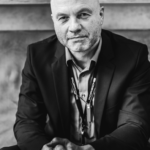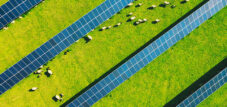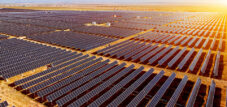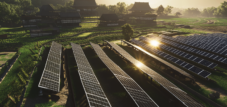Published on: March 27, 2025 / update from: March 27, 2025 - Author: Konrad Wolfenstein

The current boom of solar parks in Germany: expansion, locations and social acceptance - Image: Xpert.digital
Solar parks of the future: Germany relies on innovative solutions and citizen participation
Floating, steep, sustainable: How Germany's solar energy thinks new
Germany is currently experiencing an unprecedented expansion of solar parks in various forms and at surprising locations. The variety ranges from floating systems on excavator lakes to installations on 40-degree slopes in the Black Forest. While the country has already reached its ambitious expansion goals for 2024, in addition to technical innovations, new ways to citizen participation, which are intended to promote acceptance. At the same time, space competition with agriculture and biodiversity issues remain important discussion points. The following report illuminates the current status and the challenges in the expansion of solar parks in Germany.
The dynamic expansion of solar energy in Germany
Germany reached a significant milestone at the end of 2024: The annual expansion goal for solar systems has already been met prematurely. In total, solar systems with 13 gigawatts of new performance were installed, and around 15 gigawatts are expected by the end of the year. This development corresponds to the level of the past year and shows the continuity of solar expansion in Germany.
There are significant differences in region. Bavaria leads the statistics with 3.1 gigawatts-almost a quarter of the entire new performance, followed by Baden-Württemberg and North Rhine-Westphalia with 1.8 gigawatt. It is particularly noteworthy that some North German circles are at the top of the solar expansion, although the sunlight there is traditionally lower than in the south. In circles such as Rendsburg-Eckernförde, Steinburg (both Schleswig-Holstein), Friesland (Lower Saxony) and the Mecklenburg Lake District (Mecklenburg-Western Pomerania), more than 100 megawatts of solar performance were brought online.
The ambitions for the coming years are even higher: In 2025, new solar systems in volume of 18 gigawatt are to be built, from 2026 even 22 gigawatt annually. The overarching goal is a doubling of the total performance from currently 96 to a total of 215 gigawatts by 2030.
Large energy companies like Vattenfall have significantly reinforced their investments in this area. The company plans to put around 500 megawatts of solar power and 300 megawatts of large batteries every year-mainly in combination and often in the form of AGRI PV, which enables agriculture and energy generation in the same area.
Suitable for:
- Germany's solar energy close to the 100 GW solar mark: Why solar expansion is creating new challenges for electricity stability
The diversification of the locations
Floating solar parks as an innovative solution
A particularly innovative development are floating photovoltaic systems, so-called “floating PV”. In Bad Schönborn (Karlsruhe district), Germany's largest floating photovoltaic system was recently inaugurated. With more than 27,000 solar modules and an installed performance of 15 megawatts, it covers a good eight hectares of the Philippsee. The generated electricity primarily flows into a gravel plant at the quarry lake, while excess energy is fed into the public network. The system produces around 16 million kilowatt hours of electricity annually.
An even larger floating solar system is currently being built on the Cottbus Baltic Sea, Germany's largest mining. With a planned performance of 29 MWpeak and an area of 140,000 square meters (corresponds to 20 soccer fields), it will generate around 29,000 mWh of electricity annually after its completion in the winter of 2024/2025 - enough for around 8,250 households.
This development shows a remarkable change: where lignite has been encouraged for decades, solar power is now generated. The project has a pilot character for the LEAG that is building this system and could be the harbinger of further plants on Dachegeen in Lusatia.
Solar parks at extreme locations
Germany's steepest solar park was built in the southern Black Forest in the municipality of Fröhnd. With an average slope of 32 degrees and up to 40 degrees at the steepest point, the construction is a technical challenge. The 4.2-megawatt system with 7,200 solar modules supplies 1,500 households with electricity.
The construction work required special measures: A forest machine was used for the transport of the modules, which secured the caterpillar loaders with the 1.2 tons of pallets. For some foundations, the holes had to be dug by hand due to the local conditions and weather conditions.
This development refutes the assumption that open spaces for solar modules would be lacking in Germany. "The Solarpark in Fröhd is an outstanding example of the fact that there is no lack of open spaces for solar modules in Germany, as the 'skeptics' renewable energies like to say," said project manager Karlheinz Fichtner by Altus Renewables.
Solar parks along traffic routes
The marginal areas of highways and railway lines offer enormous potential that has so far been less used. If the area on the left and right of the highway in a corridor of 200 meters were equipped with photovoltaics, a solar park could be created that reaches the expansion of the city of Bremen.
According to the Fraunhofer Institute for Solar Energy Systems ISE in Freiburg, there is a potential of at least 72 gigawatts of installed performance along traffic routes in Germany. This corresponds to the current total capacity of photovoltaic systems across Germany and about a eighth of the required solar power output by 2045.
The Federal Government recognized this potential and decided in March 2023 the “modernization package for climate protection and planning acceleration”, which emphasizes the stronger use of the marginal areas of highways and rails for the construction of systems for the production of renewable energies. A central principle is that no kilometer motorway should be planned without exploiting the possibility of creating renewable energies.
Citizens' participation and increase in acceptance
Innovative participation models for more acceptance
Acceptance for solar parks in the population is a decisive factor for the successful expansion of renewable energies. More and more projectors and energy companies recognize the importance of citizen participation and develop corresponding models.
IBC Solar, a leading full-service provider of solar energy solutions, has launched a digital platform through which citizens can participate in solar parks. The company already enables financial investments with smaller amounts so that everyone can actively shape the energy transition.
The energy transition also belongs in town hands, we were convinced of this from the start. People want to contribute to clean energy generation, and if this is not possible through their own solar system on the roof, participation in solar parks is a good alternative, explains Udo Möhrstedt, CEO of IBC Solar AG.
The first project as part of this opportunity to participate is the Solarpark Schnaid in the municipality of Hallerndorf in the Forchheim district. With an output of 6.5 megawattpeak, this solar park will deliver around 7,000 megawatt hours of green electricity annually, which saves 4,300 tons of CO2 every year and can supply more than 2,000 three -person households with green energy for a whole year.
Suitable for:
Legal framework for citizen participation
At the federal level, project carriers have so far only been encouraged to financially involved municipalities in the construction of wind farms and photovoltaic open space systems. However, some federal states have issued their own regulations for the additional participation of the citizens.
In Mecklenburg-Western Pomerania and most recently also in North Rhine-Westphalia, the construction of wind farms has the obligation to make an offer for the citizens. However, these regulations are designed differently.
A current study by the Institute for Climate Protection, Energy and Mobility (IKEM) on behalf of the Bürgeren energy and the German Cooperative and Raiffeisenverband makes a proposal for a nationwide regulation. The proposal is based on the regulation applicable in North Rhine-Westphalia, but extends it to photovoltaic open space systems.
This proposal includes the obligation of the project carrier to submit the draft participation agreement after early exchange with the municipality and local citizens' energy actors six months after receiving the secured building law. If the negotiations are unsuccessful, the project provider has to offer the citizens on site 20 percent of the shares for sale.
Municipal income and regional added value
The financial advantages of solar parks are not only limited to the operators and investing citizens, but also extend to the municipalities. An example of this is Saxon Energy that financially involved in their photovoltaic open space systems.
All municipalities in Germany, in the area of which there is a photovoltaic open-air area of Saxony energy, receive 0.2 cents for each kilowatt hour generated. The local supplier pays this voluntary tax in full.
For the municipalities, this means considerable additional income: a solar park with an output of 10 MWP can bring in around 20,000 euros per year. In total, Saxony energy pays around 300,000 euros annually in local taxes.
"Anyone who supports the energy transition should also benefit financially. That is why we use the possibilities that the EEG offers and participate in the so-called municipal levy financially in renewable energy plants," emphasizes Saxony Energy Finance Director Dr. Axel Cunow.
Such financial participation models can significantly increase acceptance for solar parks in the municipalities and contribute to a fairer distribution of the economic advantages of the energy transition.
Challenges and controversy
Agriculture competition with agriculture
Despite the many positive developments, the use of agricultural areas for solar parks remains a controversial topic. Critics, including the Federation for the Environment and Nature Conservation (BUND) Brandenburg, warn of an irretrievable loss of agricultural areas and demand that arable land should primarily serve food and feed production.
The conflict becomes particularly clear using the example of a Brandenburg farmer who wants to lease 120 hectares of his fields for the construction of a photovoltaic system. For him, this means secure income for the next 30 years, regardless of the weather and the fluctuations in the agricultural markets. After years of crises - from declining milk price to droughts to increased energy prices - leasing appears to him as an economically sensible alternative.
The strongly fallen prices for solar modules have meant that a photovoltaic system pays off even without funding. This has triggered a real investor run on agricultural areas, which opens up new sources of income, but at the same time raises concerns about the long-term consequences for food production.
Biodiversity and sustainable land use
An important approach to solving this conflict is the development of solar parks that promote biodiversity and integrate sustainable land use concepts. The “Good Solar Parks” initiative has developed a self -obligation that enables various biotope types in the solar park, provided that the location, solar park concept and size allow.
“Biodiversity PV” can achieve the diversification desired by many farmers with economically sustainable and comparatively space-saving solar parks. This in turn keeps space for productive agriculture.
Other positive side effects of this approach are the positive effects of increased biodiversity in solar parks also on adjacent areas, contributions to erosion avoidance, for soil recovery, if necessary for humus structure and groundwater protection.
An example of this sustainable approach is the solar park in southern Black Forest, where the Schönau electricity works want to have the areas under and next to the modules grazed by sheep. In addition, retreat and nesting places for reptiles, birds and bats are created, and the edge areas outside the fence are to be developed as a lean grassland.
Germany as a hotspot: the future of solar parks
The expansion of solar parks in Germany progresses at impressive speed and increasingly takes on innovative forms. From floating systems on excavator lakes to solar parks on extreme steep slopes to installations along traffic routes - the variety of locations shows the adaptability of this technology.
The current developments make it clear that Germany is on the right track to achieve its ambitious goals for the expansion of renewable energies. By 2030, the installed solar performance should be more than doubled from currently 96 to 215 gigawatts. However, this continues to require considerable efforts and innovative solutions.
For the long -term success of solar energy, it will be crucial to further strengthen the citizen participation and create uniform framework conditions. The financial participation models for municipalities and citizens already have positive effects on the acceptance of solar parks.
At the same time, the conflict between the use of photovoltaic and agriculture must be defused by intelligent concepts such as AGRI-PV and Biodiversity PV. These approaches enable the surfaces to be used and contribute to the preservation of biodiversity.
The use of previously not yet noticed potentials, such as the outskirts of traffic routes, will probably focus even more in the future. With an estimated 72 gigawatts of possible installed performance, these areas offer enormous opportunities for the further expansion of solar energy without competing for agricultural use.
Germany shows that despite its geographical location, it can be an “unexpected hotspot for solar energy”. This development is an important contribution to the energy transition and climate protection - and will be further promoted by innovative technologies, clever land use concepts and broad social participation.
Suitable for:
Your partner for business development in the field of photovoltaics and construction
From industrial roof PV to solar parks to larger solar parking spaces
☑️ Our business language is English or German
☑️ NEW: Correspondence in your national language!
I would be happy to serve you and my team as a personal advisor.
You can contact me by filling out the contact form or simply call me on +49 89 89 674 804 (Munich) . My email address is: wolfenstein ∂ xpert.digital
I'm looking forward to our joint project.













